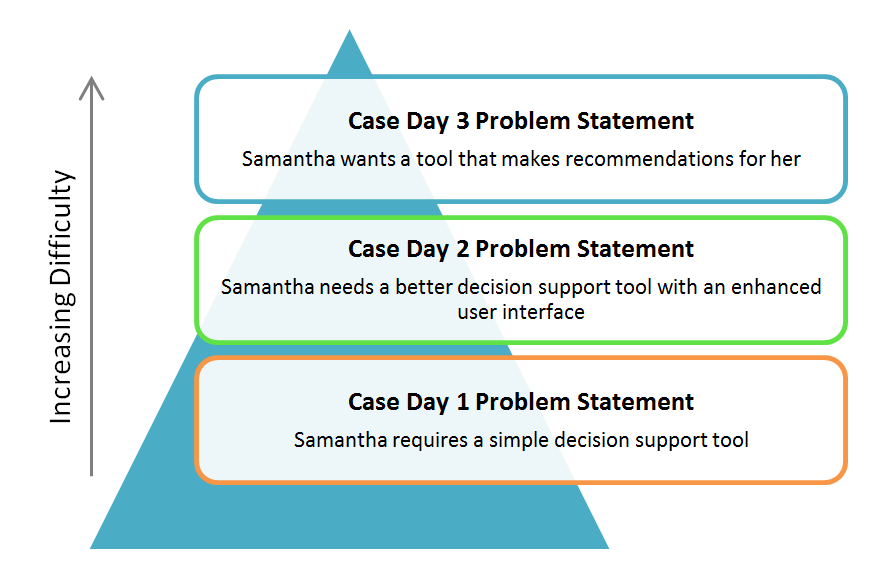
.
- Dr. Kenneth McKay, Professor and Department Teaching and Undergraduate Liaison Officer
- Instructor of MSCI 100, Fall 2015
Management Engineering Concepts (MSCI 100)
MSCI 100 is an introductory course that focuses on principles of management engineering. An overarching goal is for students to understand and apply concepts in efficiency and effectiveness. Through application of course topics, they practice time management, project planning, teamwork and communication. In the fall 2015 offering, three full days were dedicated to case studies. These three “case days” started at 8:30 am and ended at 4:20 pm. They were staggered throughout the term:
| Week | Tuesday (8:30-4:20) | Wednesday (10:30-11:20) | Thursday (10:30-11:20) |
|---|---|---|---|
| 1 | Introduction | Cause & Effect Analysis | Cause & Effect Analysis |
| 2 | Planning | Scheduling | Project Management |
| 3 | Case Day 1 | Organizations | Teams |
| 4 | Innovation & Change | Health Care & Process | Service & Financial |
| 5 | Case Day 2 | Manufacturing & Process | Midterm Review |
| 6 | Write Midterm 1 | ||
| 7 | Toyota Field Trip | Toyota Debrief | Forecasting |
| 8 | Forecasting | Inventory | Inventory |
| 9 | Case Day 3 | Assessments | Inventory |
| 10 | Inventory | Optimization | Shortest Path |
| 11 | Shortest Path | Queuing | Design Process |
| 12 | Midterm Review | Term Summary | Write Midterm 2 |
Case Study Synopsis: “Northern Canada Co-op Experience”
Although initially excited to land a co-op position, Samantha is trying to figure out the logistics of actually moving to Dawson City, Yukon, for four months. She also has to work with a student budget.

Downtown Dawson City, Yukon (WikiMedia Commons)
Knowing she is coming back after four months, Samantha wants to create a detailed plan on what to bring, buy, or go without. Luckily she has already found a place to rent: a single bedroom in a fully furnished house. Her bedroom only has a closet and a dresser with six small drawers. The rest of the space is filled up with her tiny bed. Samantha is determined that all stuff will fit into her bedroom storage areas; however, she is torn between what things to leave behind, the effort of moving and balancing a budget.
Case Day Structure

Team Advisors
Each team was given an advisor that they met with at set points throughout the case days. The role of the advisor was to support and observe. Advisors took note of the students’ abilities to manage their tasks and work as a team based on the meetings and quality of deliverables. For all advisory meetings, students had to be on time and could only ask three questions. Advisors used the Socratic Method to answer these questions and pushed students to reflect on their project management decisions.
Implementation Strategy
From case day 1 to case day 3, the support and guidance of the advisor diminished. The student teams had to apply what they learned from previous case days to solve more complex problems with fewer deliverables. Ultimately, students were scaffolded into more responsibility and less structure.

Learning Goals and Assessment
The learning goals for the case days were less focused on the mechanics of the solution and more focused on the soft skills surrounding project management. Based on the submissions to Learn and the advisor-team interactions, the following was assessed:
- Teamwork (learn to organize themselves, have clear roles and collaborate)
- Project Planning (learn to write status reports and complete quality solutions on time)
- Communication (learn to facilitate meetings wisely, apply advice from one meeting to the next and communicate effectively with team members)
- Submissions (learn to develop solutions that address requirements and write quality documents)



Student Response
The student response was overall positive. There were many comments along the following themes:
- Progression from a group to a team: it was good that we were in the same teams so we could grow and learn how to work together effectively
- Chance to learn from mistakes: reassess skills and previous decisions to plan for each case day
- Time management skills: we had to understand and solve a problem all in one day which forced us to apply best practices for handling a time-crunched project
- Teamwork: learning the strengths and weaknesses of our team members and how to use this knowledge to schedule our tasks
- It was the best part of the course!